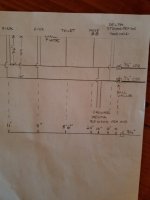Jeff Knecht
Member
Installing PEX in 24" high crawl and being 6"3", 73 years, benign tremor in the right hand and not as strong as I use to be, trying to devise a plan of attack. I would appreciate your comments.
1. Hard to get leverage on the crimper. On another install in the same area, while lying on back and making a crimp, had to hold the ring (keep from slipping) with the left hand, grip the crimper with the right hand and line up, and supported the other handle on my thigh to push against for leverage. What a dog and pony show that was.
I've been thinking, which isn't my strong point. Is there a PEX and crimp ring, friendly adhesive that can be put on the PEX to hold the ring in place? Or maybe, use a clear Scotch Tape to hold the ring in place? Or place the ring on the tube and give it a slight squeeze and slip over the fitting?
2. To avoid having to make connections on the 10 T's, pre attach all the T's outside on the garage floor and carefully, drag it into the crawl space. Or, perhaps "dry fit" the entire assembly without crimping the device feeds and see how that pans out.
3. For sink and toilet stops, crimp stops, or compression? I think Jeff Handy suggested the Dahl-Eco brand.
4. Start from the valve and connect to the T last? I figure the valve is the valve area is the most critical.
Once again, thanks for all your help.
Jeff
1. Hard to get leverage on the crimper. On another install in the same area, while lying on back and making a crimp, had to hold the ring (keep from slipping) with the left hand, grip the crimper with the right hand and line up, and supported the other handle on my thigh to push against for leverage. What a dog and pony show that was.
I've been thinking, which isn't my strong point. Is there a PEX and crimp ring, friendly adhesive that can be put on the PEX to hold the ring in place? Or maybe, use a clear Scotch Tape to hold the ring in place? Or place the ring on the tube and give it a slight squeeze and slip over the fitting?
2. To avoid having to make connections on the 10 T's, pre attach all the T's outside on the garage floor and carefully, drag it into the crawl space. Or, perhaps "dry fit" the entire assembly without crimping the device feeds and see how that pans out.
3. For sink and toilet stops, crimp stops, or compression? I think Jeff Handy suggested the Dahl-Eco brand.
4. Start from the valve and connect to the T last? I figure the valve is the valve area is the most critical.
Once again, thanks for all your help.
Jeff








